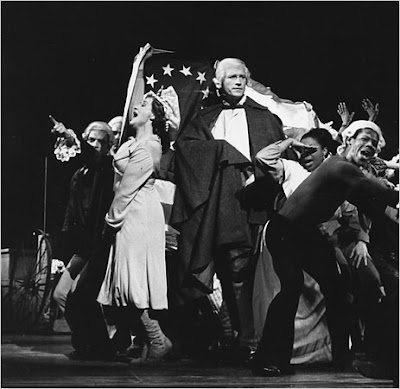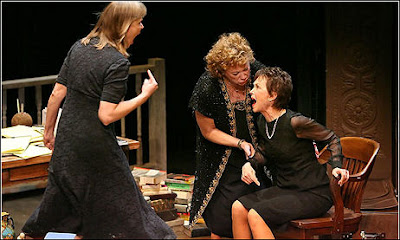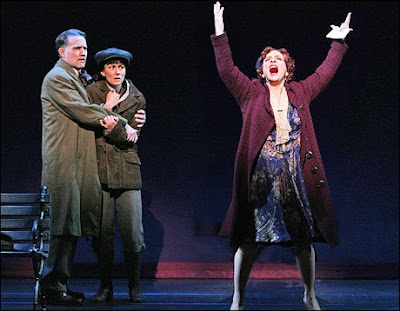Colossal failure. That’s the summation I generally give 1600 Pennsylvania Avenue, the Leonard Bernstein-Alan Jay Lerner flop that played a tumultuously chaotic out of town tryout and limped into New York for a 7 performance run. Where did it go wrong? Probably at the very start. Lerner was frustrated over the Watergate scandal of 1972 and collaborated with Bernstein on a concept musical that would examine the first hundred years of the White House, with an emphasis on race relations through that time. Highly ambitious stuff.
Tonight I was at the condensed revision of the piece (which eliminated practically the entire book and focused on the historical musical scenes) called A White House Cantata. The event was presented by the Collegiate Chorale under the artistic direction of Tony award winning actor Roger Rees and marked the NY premiere of this revision, and the first time the score had been heard in NY since it closed May 8, 1976.
The piece calls out for a more theatrical staging rather than the staid classical production it received tonight. The Collegiate Chorale stood and sat upstage in a semi circle, with four chairs and four mike stands (everyone had a binder) downstage. Chills were to be had several times throughout. “Take Care of This House” and “To Make Us Proud” (which reminded me so much of “Make Our Garden Grow”) are stunning pieces. The crescendo of the latter was beyond gorgeous. (“To Make Us Proud” should never have been cut as the finale. It is a stunning summation of liberal patriotism – and that last note is held forever and a day). Hearing those original orchestrations (by Bernstein, Hershy Kay and Sid Ramin) was worth the price of admission alone. Dwayne Croft was amusing as the President, and in stellar voice, if no great shakes as an actor. Emily Pulley‘s “Duet for One” was well executed – she found the comedy where June Anderson failed in the initial presentation/recording ten years ago. And needless to say, the number stopped the show. However – she did not take the high D above C at the end which separates the good First Ladies from the superlative First Ladies (like Patricia Routledge and Judy Kaye, who made the first official recording of the showcase for John McGlinn). Robert Mack and Anita Johnson were fine as Lud and Seena; especially with the infectious “I Love My Wife.” Rees also made an amusing cameo as Admiral Cockburn during the “Sonatina.”
As the show is performed now, with practically nothing left of the book it runs an intermission-less 90 minutes. Basically it’s everything you hear on the disappointingly lifeless album they recorded after the London premiere ten years ago (with Thomas Hampson and June Anderson). But I feel though that by removing the entire book, you’re left with just songs and little context. They tried to make up for that with a historical Powerpoint presentation that lasted the entire performance. They also wisely used supertitles for lyrical clarity. Which brings me to my aforementioned quibble. The piece is eminently theatrical and not classical – it would have fared better with musical theatre actors in the leads. Say for instance, Marc Kudisch and Victoria Clark as the President and First Lady. (Let’s face it, Victoria Clark should just do the Patricia Routledge songbook). There was a lack of cohesion that was made even more obvious with the lack of dialogue or even a narration. Hmm.. That sounds like an idea for the cantata, link the fragmented musical sequences with narrative. That would make more sense than just jumping from one musical piece to another. It could also help the audience care more for Lud and Seena, since they are the fictional characters of the piece, who really come out of nowhere and go nowhere, except to serve as catalysts for racial discussion within the musical numbers. We should have an opportunity to care for them. But let’s face it, it is a problematic show, otherwise it wouldn’t be obsessed by elitists and curious flop fiends.
I am, as many of you are well aware, fascinated to no end by the piece, especially since it’s one of such breadth and scope. And there seems to be a masterwork yearning to break out of the confines of the show in each of its revisions. I found that there was more fun to the piece when it was a Broadway musical and not an oratorio (the piece demands the energy and acting, especially in regards to the satiric numbers). They’ve reinstated the much more reserved original Prelude as opposed to the lively overture that opened the show on Broadway (which is decidedly Bernsteinian) and the framework of “Rehearse” which is infectious and little tidbits, like “The Honor of Your Presence is Requested” which for whatever reason I just love the melodic line. The impeachment scene between President Johnson and Seena is one of the most compelling dialogues that the show had to offer. It was nowhere to be seen. In fact, the servants rarely interact with the President and First Lady in the revision. The fragmentation sort of defeats the author’s original intent, doesn’t it?
The following quote from John Adams’ correspondence with his wife Abigail, written on his second day of occupancy was missing – and it makes for a beauty of a line:
“I pray Heaven to bestow the best of blessings on this House, and all that shall hereafter inhabit it. May none but honest and wise men ever rule under this roof.”
After the show, there was a highly engaging talkback hosted by Seth Rudetsky with Richard Muenz, Beth Fowler, co-director George Faison and Fowler’s husband John Witham (they met during this production and were married a year later). Also present was Warren Hoge, who covered the show during its preview period in 1976 – and told an amusing anecdote about how he sang “Take Care of This House” to Ronald Reagan at a White House dinner. One of the audience questions was actually a comment from a man who was at the closing and recalled how Routledge received such an ovation for “Duet for One” that she performed an encore. Fowler backed him up saying it was the only time she had ever seen anything like that “They wouldn’t let the show go on.” She also does a rather amusing Pat Routledge impersonation. They mused on what worked and didn’t work. The chaos of rehearsals and being out of town. The confusion of having rehearsed half a scene, only to perform the new first half and the old second half at the evening perform. Yikes. Many mixed reactions on the original work from all onstage. “A wonderful-terrible experience.” They were all thrilled to hear the score again – and Faison summed it up best when he said that Lerner and Bernstein were trying to say too much.
Erik Haagensen, who was cited in the concert notes as having written an article about the musical for Show Music magazine in 1992, has worked on an estate-approved revision of the work that was done in the early 90s. What a shame we can’t get his work out in the open, because I feel that there is a masterwork among this ruin that has yet to surface.
One final quibble. For a show that deals with race it was jarring that the chorale was almost all white, with nary an African American woman in sight, save for Ms. Johnson.
While it was a treat to hear the piece live in NY, A White House Cantata is not and should not be the final word on this score.




